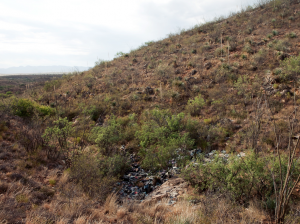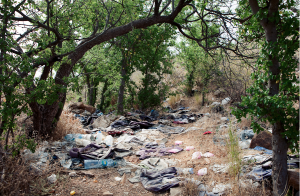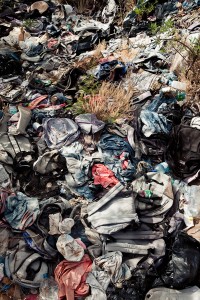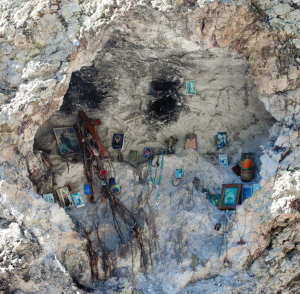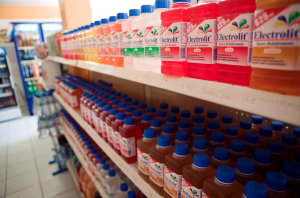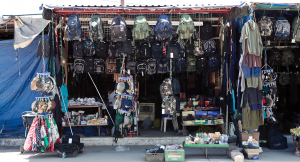Migration from Mexico to the US is the largest and most continuous migration in the history of the world. A large proportion of the undocumented Mexican population in the US entered the country through the 1,952 mile southwest border between Mexico and the US.
Jason De León, assistant professor of anthropology at the University of Michigan and creator of the Undocumented Migration Project (UMP), remarks that despite the social, political and economic importance of migration across the US-MX border, there is surprisingly little scientific research exploring this process. I spoke with De León to learn more about the UMP and how it could inform us about the experience and phenomenon of border crossing.
The beginnings of the Undocumented Migration Project (UMP)
Before De León developed the UMP he had been carrying out archaeological research in Mexico for more than eight years, most recently to complete doctoral research on the ancient Olmec. Due to the proximity of his dig sites to communities in Mexico with high out migration rates, Mexicans who were preparing for, or returning from, a border crossing would often work temporarily at the sites. De León made friends with many of the migrants passing through and their poignant stories stuck with him. For De León, a grandson of an undocumented Mexican migrant, migration was always in the background, but these encounters brought this interest to the fore.
He began to shift his academic focus away from Olmec lithic technology—the topic of his doctoral thesis, which he admits, ‘was a bit difficult to get excited about after looking at 50,000 rocks’—and towards the anthropology of migration. Also at this time, an archaeologist friend commented that at her own dig site in Southern Arizona, she had found some objects presumably left behind by migrants crossing the border. Curious about these objects, De León took a trip to the Sonora desert to investigate them. He found water bottles, shoes, family photographs, bus tickets, candy wrappers and other materials. He realised that these objects could help to document the process of border crossing and how it has changed over time.
What is the goal of the UMP?
The UMP, developed at the end of 2008, has two main components. Firstly, it involves the collection of objects left by migrants crossing through the Sonora Desert between northern Mexico and southern Arizona. The archaeological work is complemented by ethnographic research with migrants in border areas of Nogales and Altar, Mexico (this research will be extended in Summer 2012).
The objectives of this project are to use material culture and ethnography to understand the process of border crossing and the social space in which it is carried out. The project explores migrant experiences, the routinised violence occurring at the border and the political economy of border crossing and human smuggling.
Due to the negative reaction to undocumented migration in the mainstream media and public sphere, De León regrets that there are few spaces in which migrants feel comfortable to openly share their experiences. Further, the clandestine nature of border crossing makes it hard and ethically challenging for researchers to directly study it. He hopes to capture what is being said and the objects left behind so that there is a historical record of this social, political and economic phenomenon and the hardship suffered by migrants at the border.
Who is migrating?
Migrants are usually led through the desert with a coyote, or guide, an arrangement they often make in their hometown. Alternatively, they may purchase a coyote when they arrive to the border towns, these are often less expensive and less reliable.
De León estimates that approximately 90% of the people crossing the border are Mexican and the other 10% are Central Americans. He acknowledges, however, that determining the nationality of migrants through the archaeological record is particularly difficult, especially because Central Americans often portray themselves as Mexicans so that if they are apprehended they will be repatriated to Mexico rather than their country-of-origin. In this way, they can attempt a re-crossing more easily.
De León emphasises that it is not just men migrating across the border, but, in fact, clothes, shoes, toys and pre-natal pills found in the archaeological record suggest that men, women and children alike are enduring this journey.
Migration routes: from border cities to the Sonoran Desert
After 9/11, there has been an increase in spending on border security especially in cities in Texas and California. As a result of increased surveillance, migrant traffic has been funneled away from urban locales, towards the inhospitable Sonora Desert. Today, this desert area is the busiest region for migrant entry along the US-MX border. This region, located along the border between Sonora, Mexico, and Arizona, US, is referred to as the Tucson Sector. In 2010 approximately 500,000 apprehensions were made along the entire US-MX border and while that was a slight decrease from the previous year, in the Tucson Sector, apprehensions and border deaths increased.
Not only is migration through the Sonora Desert more physically arduous than migration through border cities, but research also suggests that desert routes are becoming more dangerous each year. De León’s team has documented and dated rest stops in the desert where migrants pause to hide, rest, eat or change clothes along their journey. Their research suggests that as compared to older rest sites, more recent sites are located in increasingly isolated areas where the terrain is more treacherous to hike. As a result, a crossing that may have taken three days, a few years ago, may take as long as a week, especially if individuals get separated from their coyote. In some extraordinary cases, some people may wander the desert for over seven days.
De León suggests that the length of time needed to travel these routes makes dehydration a bigger risk since few people can physically carry enough water with them. Furthermore, although these remote routes are less scrutinised by the Border Patrol, migrants travelling in these areas are more vulnerable to unscrupulous coyotes, human traffickers and thieves that operate in this space.
Water & Energy
Interview and archaeological evidence confirm the efforts made to avoid dehydration and to sustain energy during the crossing. Coyotes often recommend that the slower members of their group take ephedrine-based pills so that they can stay apace with the others. This may give migrants an initial jolt of energy but ultimately it is dehydrating, especially in temperatures that may reach 46° degrees Celsius at midday. The critical need for energy and water is evidenced through the sheer number of caffeine pills, electrolyte drinks, Red Bull, Gatorade, Monster energy drinks and water jugs that are found in the archaeological record. The remains of high-salt foods, such as saltines, canned tuna and beans are also common suggesting attempts to replenish salt to the body.
De León’s team has also found a variety of water bottles given out by the NGO Samaritan Patrol, whose volunteers hike through the desert providing water and assistance to migrants in need. These water bottles have coordinates written on them so that the volunteers can track the movement of migrants to determine their routes and ultimately where water and assistance is most needed.
The objects left behind
Backpacks of all colors, shapes and sizes are found covering the floor of the migrant rest stops. De León suggests that by estimating the number of book bags found at a site, one can loosely estimate the density of foot traffic in the area. First aid kits and salves for blisters, insulin and pain relievers, phones, as well as pocket mirrors to flag down a helicopter if a migrant is in trouble are all common items that De León’s team has catalogued.
At some of the rest stops there is also a preponderance of clothes, socks, toothpaste, and deodorant. De León believes that these sites may serve as the last rest stop before migrants enter the US. His research suggests that this is where the coyotes instruct the migrants to change and discard their clothes and wash up so that authorities and thieves cannot detect that they just crossed the border. At earlier migrant stations, some dated to 2007, De León has found hairdryers and high-heeled shoes, which suggests that, often times, migrants are not fully informed about how arduous the journey will be.
De León has also documented (and left in place), a prevalence of prayer cards, candles, wooden crosses and rosary beads. Often these objects are arranged in a rock niche or tied around a natural feature in the landscape. Images of Santo Toribio Romo, a patron saint believed to watch over migrants making the crossing, as well as La Virgen de Guadalupe, Santa Muerte and Jesus Malverde are frequently found in the desert by De León and his team.
Violence in migration
The ethnographic research that De León has carried out, underscores the physical, sexual and psychological violence that is experienced by migrants in their efforts to cross the border. Bajadores or thieves operate in towns on both sides of the border as well as in remote areas of the desert. They may attack, rob and kidnap migrants just as they begin their journey. Often bajadores work in collusion with the coyotes or human smugglers who have been paid to guide the migrants.
Bajadores also wait in Mexican border towns for the migrants who have been unsuccessful in crossing the border or who have been separated from their coyote. Migrants are easily identifiable, often dressed in black or camouflage clothing (thought to make them less visible) and hiking boots and lacking water and food. Bajadores take advantage of the vulnerable conditions in which migrants return to Mexico.
Exacerbating the situation is the fact that Border Patrol repatriates migrants to Mexican border towns that are different than those from which the migrants left (i.e. lateral repatriation). This is an effort to reduce the chances that Mexicans will attempt another crossing through the desert; however, it often results in Mexicans re-entering the country with little knowledge of where they are, thus, making them easy targets of bajadores.
Gendered violence
Female migrants are often victims of sexual violence at the hands of bajadores and coyotes. Ethnographic interviews in border towns and at migrant shelters illustrate the frequency of sexual assault and rape occurring during the process of migration.
Chillingly, the archaeological record provides evidence of female undergarments hanging from trees in the desert. Although, De León emphasises that the archaeological record cannot confirm the exact meaning of these trees, interviews describe that such trees mark acts of rape and sexual assault, or serve as symbolic threats of sexual violence, which aim to intimidate migrants into cooperation with the thieves and smugglers that operate in the desert.
Global economies, inequalities & the commoditisation of border crossing
Although border crossing is often depicted as a clandestine activity occurring in the mythologised ‘borderlands’, De León’s research highlights the inter-connectedness between migrant crossings and larger political-economic forces such as US migration policies and security measures, NAFTA, global markets and north-south inequalities. His research also clarifies the way in which the process of migration has been commoditised and exploited to serve various interests.
The border towns, as well as the bajadores and coyotes circulating through these towns, have made an industry out of border crossing. The streets are lined with street stands selling backpacks, black shirts, shorts, hiking boots and other materials needed for the crossing. The shelves of the tiendasare piled high with electrolyte and energy drinks. De León notes that in a tiny border area of Altar, Mexico, there are at least six factories that produce water bottles specifically for migrants. Many companies have begun to produce black water bottles to respond to the fact that migrants would often cover white bottles with a black bag to make them harder to detect at night. Some bottles have images of Baboquivari on them, which is the rock peak used as a landmark by migrants crossing the border. These products illustrate the political economy of border crossing and its commodification.
Issues of representation & fetichisation
De León is self-reflexive about his research methods and approach. He emphasises the importance of contextualising his archaeological material with ethnographic research to understand the reality of border crossing. He is cautious to avoid overly artistic or ‘sexy’ photos of the artifacts founds in the desert, which he fears may serve to objectify the phenomenon of border crossing and stand in as a metonym for it.
He believes that archaeology and ethnography are rigorous methods for systematically understanding the chaotic process of border crossing. He is careful, however, not to let his method eclipse the larger aims of his project. Ultimately, he is prepared to incorporate other methodologies if they help to explain the realities of border crossing and the political-economic and social contexts that shape it.
Related Links
Pringle, Heather (2011). The Journey to El Norte. Archaeology. 64(1).
http://www.archaeology.org/1101/features/border.html
Michael Wells Photography
http://www.mwellsphoto.com/work/border-projects/undocumented-migration-project-2010/
Jason De León
http://jasonpatrickdeLeón.com/research/
